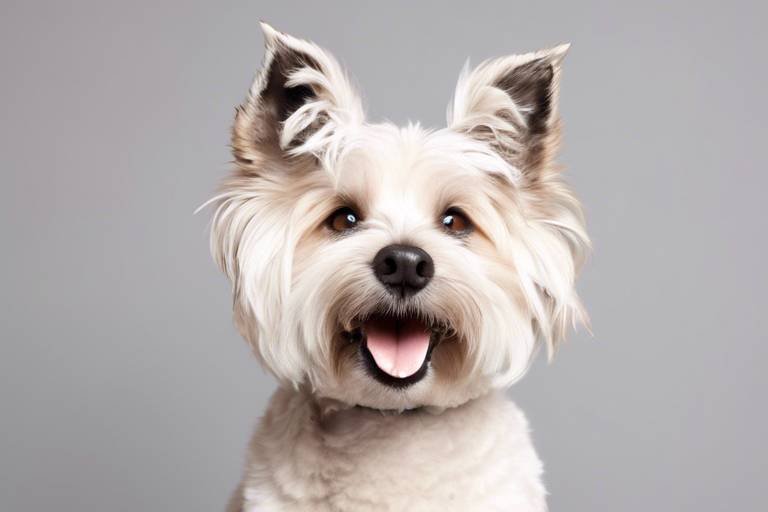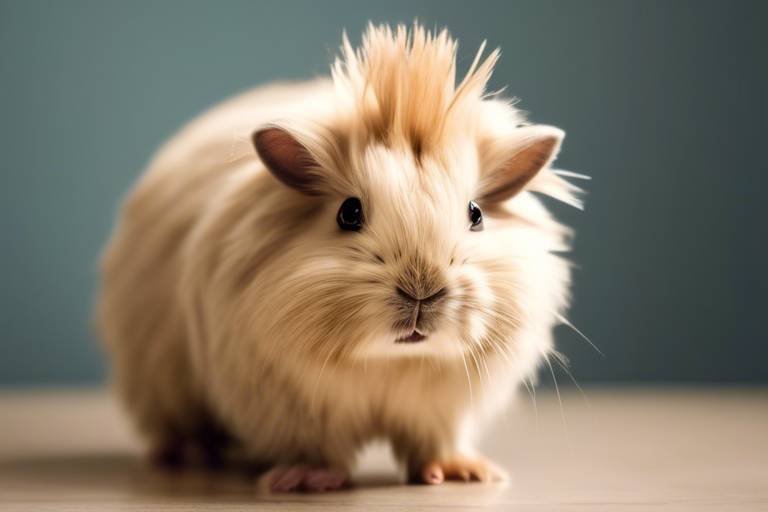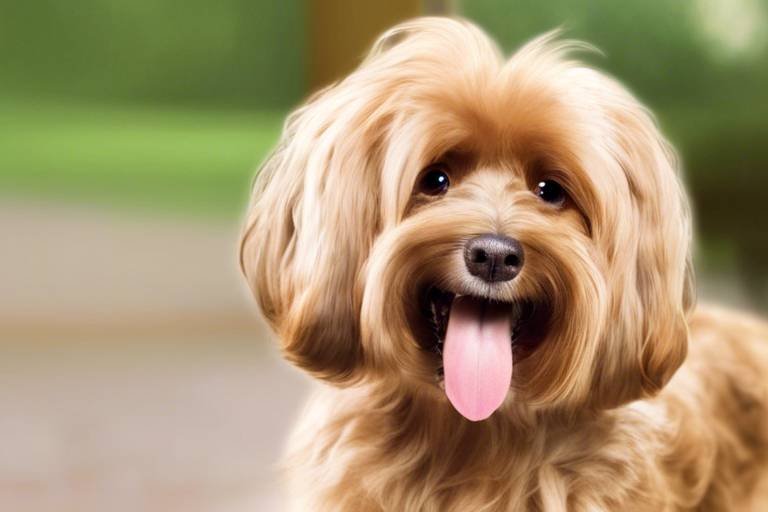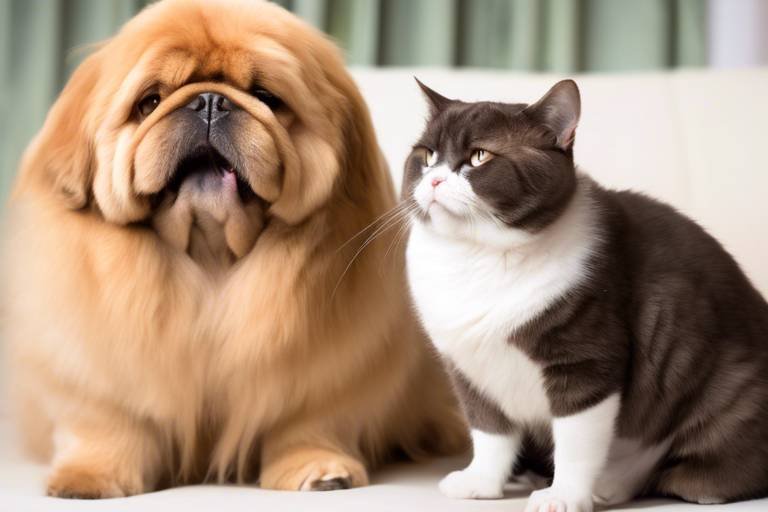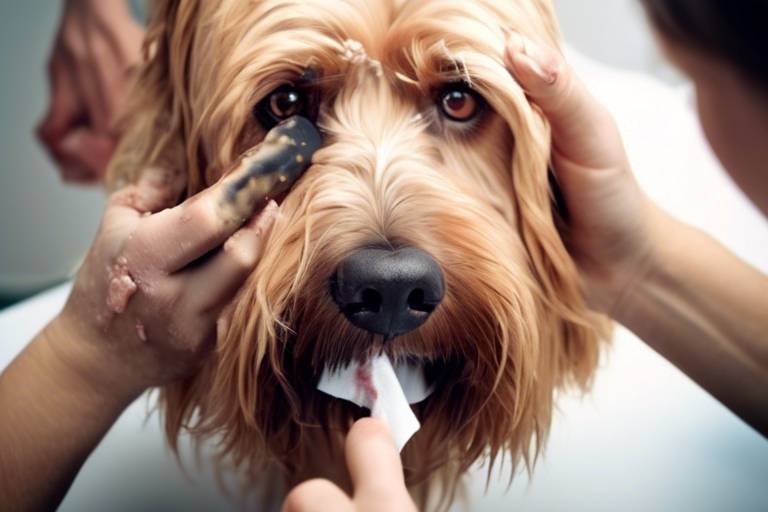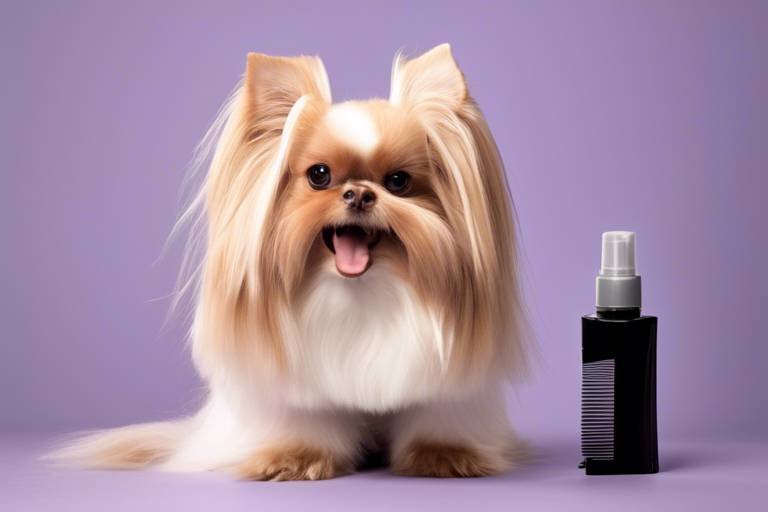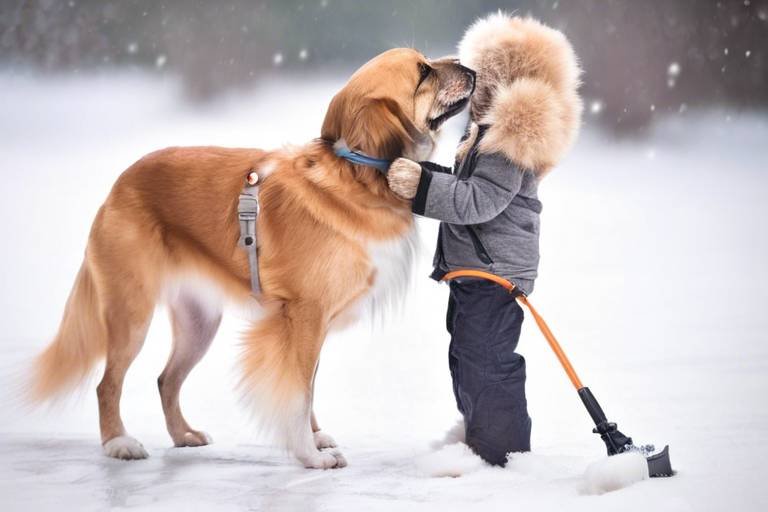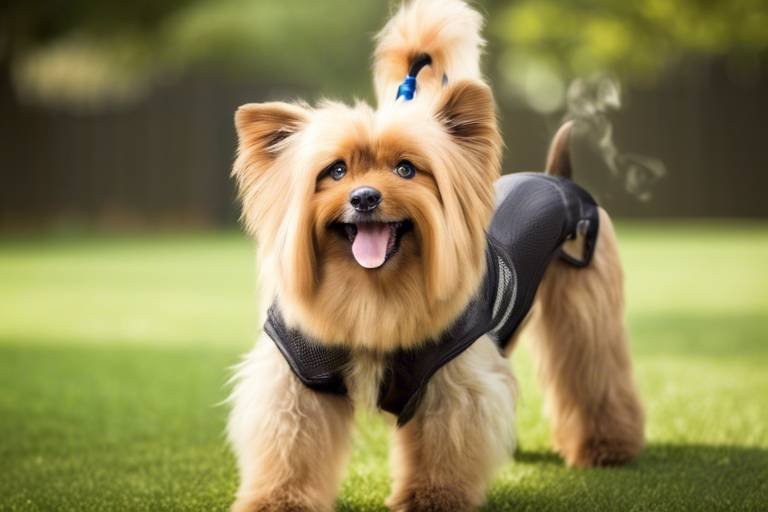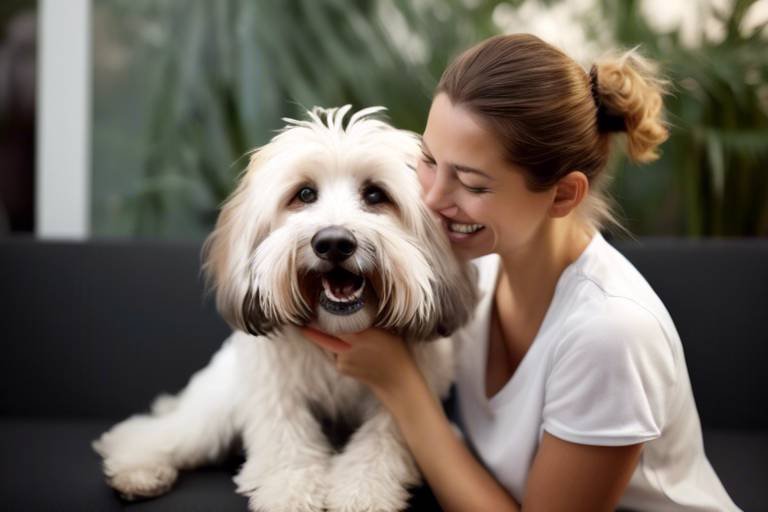How to Help Your Pet Cope with Grooming Changes
Grooming can be a challenging experience for many pets, especially when changes occur. Whether it's a new grooming tool, a different groomer, or simply a shift in routine, these alterations can lead to anxiety and discomfort for your furry companions. As a pet owner, it’s crucial to understand how to navigate these changes effectively. By implementing some thoughtful strategies, you can help your pet feel more at ease and transform grooming from a stressful ordeal into a pleasant bonding experience.
Imagine this: your pet is like a child who is suddenly thrust into a new environment. They may feel overwhelmed, unsure, and even frightened. Just as we would comfort a child in a new situation, it's essential to offer your pet the same level of support. This article dives deep into understanding your pet's grooming needs, recognizing signs of anxiety, choosing the right tools, establishing a routine, and knowing when to seek professional help. Together, we’ll explore how to make grooming a positive experience for both you and your beloved pet.
Every pet is unique, and so are their grooming requirements. Some pets may have long, flowing coats that require regular brushing, while others may have short hair that needs less maintenance. Recognizing these individual needs is the first step in creating a comfortable grooming experience. For instance, a dog with a thick double coat will need different tools and techniques compared to a short-haired cat. Tailoring your grooming approach not only ensures your pet's comfort but also helps reduce stress levels significantly.
Moreover, consider your pet’s personality. Some pets are naturally more anxious than others. A timid cat might need a gentler touch and a quieter environment, whereas a more confident dog might thrive with a more robust grooming routine. Understanding these nuances can make all the difference. It’s akin to knowing how to handle a delicate flower versus a sturdy weed; each requires a different approach to flourish.
Being able to identify signs of anxiety in your pet during grooming is crucial. Just like humans, pets express their discomfort in various ways. They might not be able to vocalize their feelings, but their behavior can speak volumes. Common signs of grooming anxiety include excessive barking, growling, or even attempts to escape the grooming area. If your pet is displaying these behaviors, it’s essential to take a step back and reassess the situation.
Behavioral changes can manifest in many forms. For example, a pet that usually enjoys being brushed may suddenly resist or try to hide when it’s time for grooming. This shift can be alarming, but it’s often a sign that something is amiss. Understanding these indicators can help you address their fears effectively. It’s like tuning into a radio station; you need to adjust the dial to find the right frequency where both you and your pet feel comfortable.
Pay close attention to your pet’s vocalizations and body language. Whining, growling, or even a sudden stillness can indicate anxiety. Similarly, a tucked tail, flattened ears, or wide eyes can signal fear. Learning to interpret these signals can guide you in providing better support during grooming. Just as we might read the room in a social setting, we must also read our pets’ emotional states to create a supportive grooming environment.
Physical reactions such as trembling, hiding, or excessive licking can signal discomfort. Recognizing these signs early allows for timely interventions to ease your pet's anxiety. If your pet is trembling, it might be a good idea to take a break and try again later. This approach is similar to how we might pause a stressful task to gather our thoughts; sometimes, a little break is all that’s needed to reset the mood.
The environment in which grooming takes place plays a significant role in your pet's comfort. A noisy, chaotic space can heighten anxiety levels, while a calm and familiar setting can promote relaxation. Consider grooming your pet in a quiet room where they feel safe and secure. This space could be their favorite spot in the house, surrounded by their toys or blankets. Just like we feel more at ease in our own homes, pets also thrive in familiar environments.
- How often should I groom my pet? The frequency of grooming depends on your pet's breed and coat type. Long-haired breeds may require grooming several times a week, while short-haired pets might only need it once a month.
- What tools do I need for grooming? Essential grooming tools include brushes, combs, clippers, and scissors. Choose tools that are appropriate for your pet's coat type.
- How can I calm my pet during grooming? Use positive reinforcement techniques, such as treats and praise, to create a positive association with grooming. Take breaks if your pet seems anxious.
- When should I seek professional help? If your pet shows extreme signs of anxiety or if grooming becomes a constant battle, it may be beneficial to consult a professional groomer who understands your pet's needs.
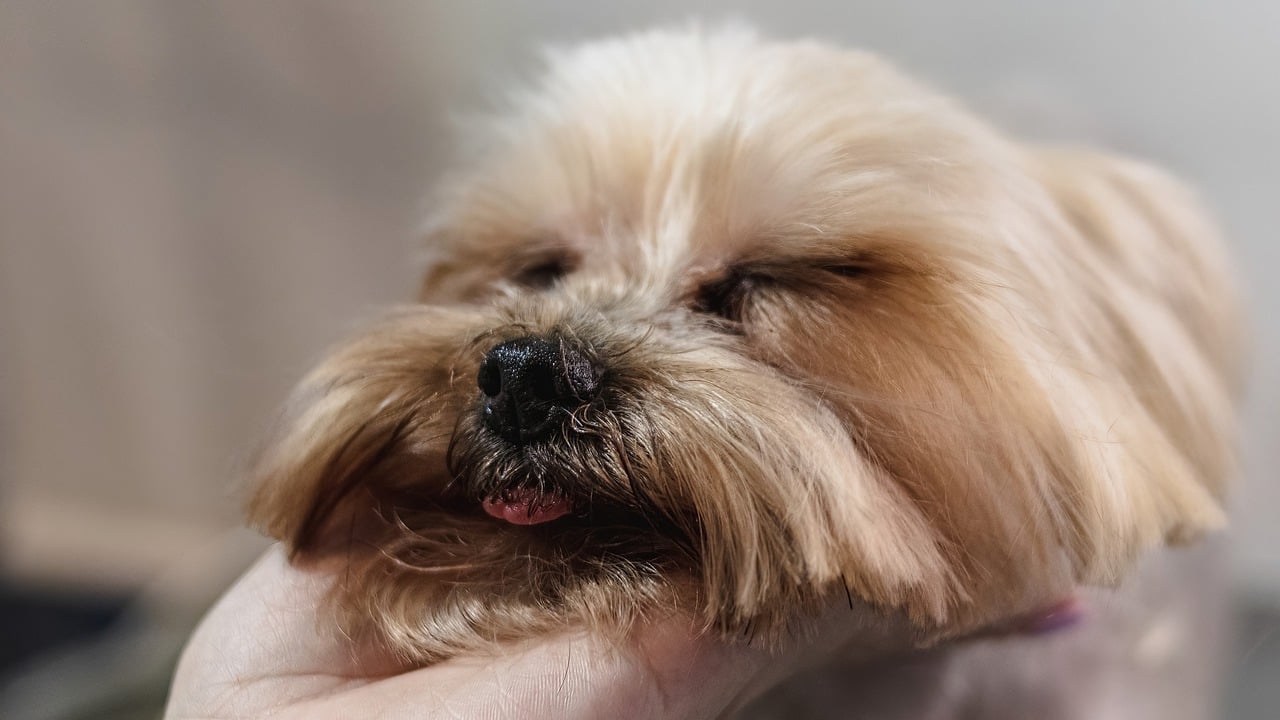
Understanding Your Pet's Grooming Needs
Every pet is a unique individual, and just like us, they have their own specific grooming needs. Understanding these needs is essential for ensuring that your furry friend remains comfortable and stress-free during grooming sessions. For instance, long-haired breeds such as Persian cats or Golden Retrievers require more frequent grooming compared to short-haired breeds like Beagles or Boxers. This difference is primarily due to the varying amounts of shedding and the tendency of long fur to tangle and mat.
To tailor the grooming process effectively, it’s important to consider several factors:
- Coat Type: Different coat types require different grooming tools and techniques. For example, a curly coat may need special combs to prevent matting, while a straight coat may just need a simple brush.
- Skin Sensitivity: Some pets have sensitive skin that can react negatively to certain grooming products. Always opt for hypoallergenic shampoos and conditioners if your pet shows signs of irritation.
- Age and Health: Older pets or those with health issues may require gentler grooming techniques. Always consult your veterinarian to determine the best grooming practices for your pet's condition.
Additionally, regular grooming is not just about aesthetics; it plays a crucial role in your pet's overall health. Grooming helps to remove dirt, debris, and parasites, while also allowing you to check for any unusual lumps or skin conditions. Establishing a routine that suits your pet's specific needs can make the process smoother and more enjoyable for both of you.
Ultimately, the goal is to create a positive grooming experience that reinforces trust between you and your pet. By paying attention to their grooming needs and making adjustments as necessary, you can help your furry friend feel more at ease during what can often be a stressful time.
Here are some common questions pet owners have about grooming:
- How often should I groom my pet? This depends on the breed and coat type. Long-haired pets may need grooming several times a week, while short-haired pets may only need it once a month.
- What tools do I need for grooming? Basic grooming tools include brushes, combs, nail clippers, and pet-safe shampoos. The specific tools depend on your pet’s coat type.
- Can I groom my pet at home? Yes, many pet owners successfully groom their pets at home. However, for certain breeds or specific grooming needs, you may want to consult a professional groomer.
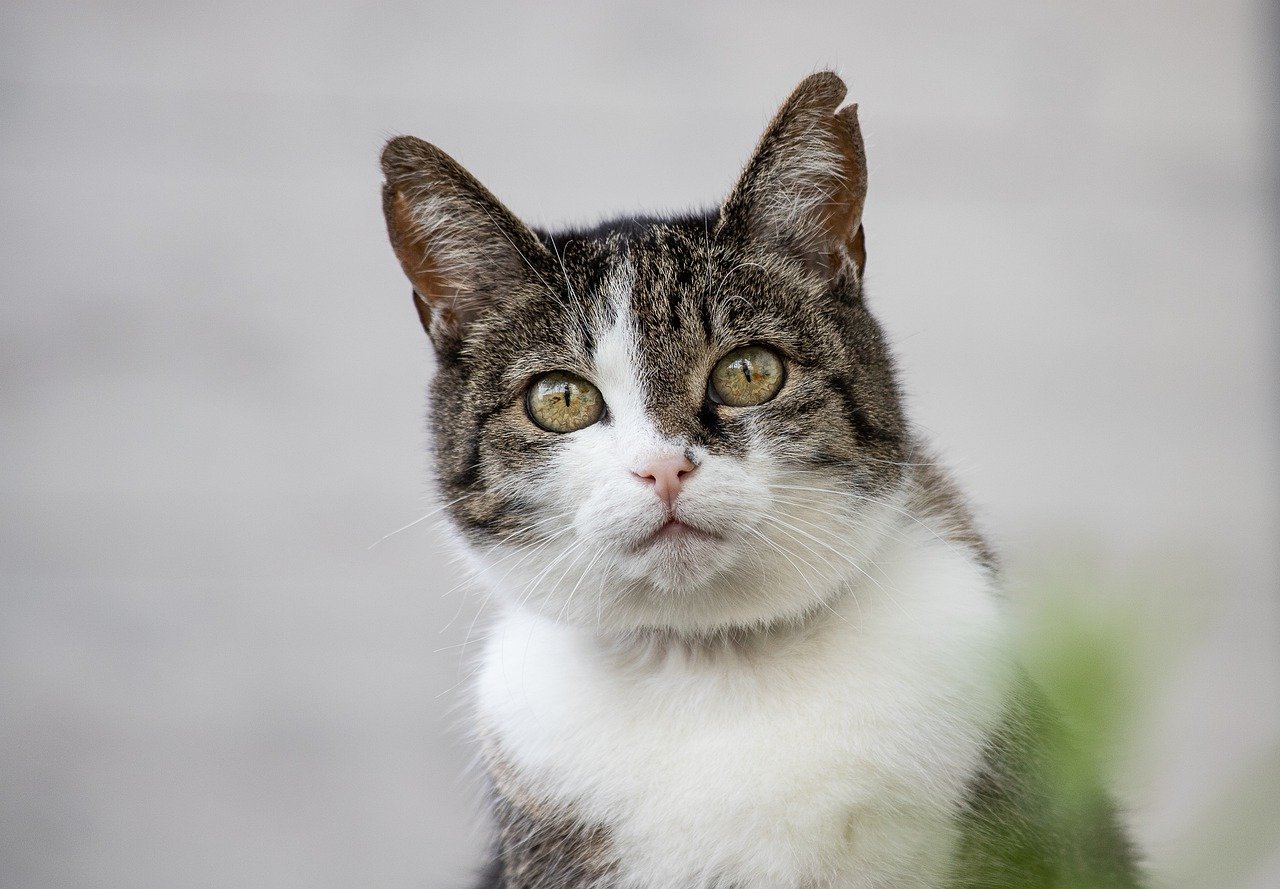
Signs of Grooming Anxiety in Pets
When it comes to grooming, pets can have a wide range of reactions, and it's essential to recognize the signs of anxiety to ensure a positive experience. Just like us, our furry friends can feel nervous or scared, especially when faced with unfamiliar tools or environments. So, how do we know if our pets are feeling anxious during grooming? By observing their behavior closely, we can identify key indicators that suggest they might be uncomfortable.
One of the most telling signs of grooming anxiety is behavioral changes. This can manifest in various ways, such as excessive panting, pacing, or even attempting to escape the grooming area. For instance, if your dog suddenly starts hiding under the couch or your cat runs away when they see the grooming tools, these are clear signals that they are not at ease. Understanding these behaviors can help you take the necessary steps to create a more calming environment.
Behavioral indicators can provide insight into your pet's emotional state. For example, if your pet is usually playful but becomes withdrawn during grooming sessions, it might be time to rethink your approach. Pay attention to changes in their usual demeanor, as this can indicate stress. Some common behavioral signs of grooming anxiety include:
- Hiding or trying to escape
- Growling or hissing
- Excessive licking or chewing at their paws
- Panting or trembling
Vocalizations and body language are also crucial in interpreting your pet's feelings. If your dog is whining or your cat is meowing excessively during grooming, these vocal cues may signal distress. Additionally, body language can tell you a lot about how your pet feels. Look for signs such as:
- Tail tucked between the legs
- Flattened ears
- Wide eyes or darting gaze
- Rigid body posture
Learning to interpret these signals can guide you in providing better support during grooming, helping to ease their anxiety.
Physical reactions can also indicate that your pet is feeling uncomfortable. Signs such as trembling, excessive drooling, or even attempting to bite can all be red flags. If you notice your pet shaking or trying to escape, it’s essential to pause the grooming session. Recognizing these signs early allows for timely interventions to ease your pet's anxiety.
The grooming environment plays a significant role in your pet's comfort. A calm and familiar space can greatly reduce stress during grooming sessions. For instance, if you usually groom your pet in a noisy area, consider moving to a quieter room. Additionally, having familiar scents or toys nearby can help soothe anxious pets. If you can create a space that feels safe and secure, you’ll likely see a marked improvement in your pet’s behavior during grooming.
In conclusion, being aware of the signs of grooming anxiety in your pets is crucial for their well-being. By recognizing behavioral changes, vocalizations, body language, and physical reactions, you can take proactive measures to ensure a more comfortable grooming experience. Remember, a little patience and understanding can go a long way in helping your furry friend feel at ease.
Q: What should I do if my pet shows signs of anxiety during grooming?
A: If your pet exhibits signs of anxiety, it’s best to stop the grooming session and give them some time to calm down. You can try to reintroduce grooming gradually, using treats and positive reinforcement to create a more positive association.
Q: How can I help my pet feel more comfortable with grooming?
A: Establishing a routine, using calming tools, and ensuring a comfortable environment can help. Additionally, consider using treats and praise to encourage your pet during grooming sessions.
Q: When should I consider seeking professional help for grooming?
A: If your pet's anxiety is severe or if you feel uncomfortable grooming them yourself, it may be time to seek help from a professional groomer who understands how to handle anxious pets.
Behavioral Indicators
When it comes to understanding our furry companions, serve as a window into their emotional state, especially during grooming sessions. Just like humans, pets can feel anxious or uncomfortable, and they often express these feelings through various behaviors. It’s crucial to recognize these signs to provide the necessary support and create a more positive grooming experience.
One of the most common indicators of anxiety in pets is their body language. For instance, if your pet is constantly turning their head away or trying to escape the grooming area, it’s a clear sign that they are feeling uneasy. Similarly, a pet that flattens its ears against its head or tucks its tail between its legs is likely expressing fear or discomfort. These subtle cues can often be overlooked, but they are essential in understanding how your pet feels.
Additionally, you may notice changes in your pet’s vocalizations. Some pets may whine, growl, or even bark during grooming, which can indicate stress or a desire to avoid the situation altogether. It’s important to pay attention to these sounds, as they can provide valuable insight into your pet’s emotional state. Remember, each pet is unique; what might be a sign of anxiety for one could be a normal behavior for another. Therefore, getting to know your pet's typical behaviors is vital.
Furthermore, physical reactions can also serve as significant indicators of grooming anxiety. For example, if your pet begins to tremble, excessively lick their lips, or hide away, these are clear signs that something isn't right. Understanding these physical manifestations of anxiety can be incredibly helpful. When you recognize these signs early, you can take proactive steps to ease your pet's discomfort. Consider creating a more calming environment or using soothing techniques to help your pet feel more at ease.
In summary, being attuned to your pet's behavioral indicators can make a world of difference. By observing their body language, vocalizations, and physical reactions, you can better understand their feelings during grooming sessions. This awareness not only helps in addressing their fears but also fosters a deeper bond between you and your furry friend, ensuring that grooming becomes a more pleasant experience for both of you.
- What are common signs of grooming anxiety in pets?
Common signs include trembling, hiding, excessive vocalizations, and changes in body posture. - How can I make grooming less stressful for my pet?
Establishing a routine, using positive reinforcement, and ensuring a calm environment can help. - When should I consider seeking professional help for grooming?
If your pet shows extreme anxiety or fear, it may be beneficial to consult a professional groomer who understands your pet's needs.
Vocalizations and Body Language
When it comes to understanding our pets, vocalizations and body language are like their personal languages. Just like us, pets express their feelings through sounds and physical cues. For instance, a happy dog might wag its tail and bark excitedly, while a cat could purr contentedly as it curls up beside you. However, during grooming, these signals can change dramatically, and it’s essential to pay close attention.
Imagine you’re at the dentist; you might not be thrilled about it, right? Your pet feels similarly about grooming. If you notice your furry friend whining, growling, or even yelping, these vocalizations are clear indicators of discomfort or anxiety. On the flip side, if your pet is quiet and still, it might be a sign of fear or submission. Understanding these vocal cues can help you gauge how your pet is feeling during the grooming process.
Body language plays an equally crucial role. For example, a relaxed pet will have a loose body posture, ears in a neutral position, and may even roll over for a belly rub. Conversely, a tense body, tucked tail, or flattened ears can indicate that your pet is feeling stressed or frightened. Here are some common body language signals to keep an eye on:
- Tail Position: A wagging tail usually indicates excitement, while a low or tucked tail suggests fear.
- Ears: Ears that are perked up generally show curiosity, whereas ears that are pinned back can signal anxiety.
- Eyes: A relaxed gaze is a good sign, while wide eyes or dilated pupils can indicate stress.
By learning to interpret these vocalizations and body language cues, you can create a more supportive and understanding grooming environment for your pet. It’s all about being attentive and responsive to their needs. Remember, a calm pet is a happy pet, and recognizing their feelings can help transform grooming from a stressful ordeal into a pleasant experience.
Q: How can I tell if my pet is anxious during grooming?
A: Look for signs like vocalizations (whining, growling) and body language (tucked tail, flattened ears). These indicate discomfort or fear.
Q: What should I do if my pet shows signs of anxiety?
A: Take breaks during grooming, use calming techniques, and consider positive reinforcement to help ease their anxiety.
Q: Is it normal for pets to dislike grooming?
A: Yes, many pets are not fond of grooming. It’s essential to be patient and work with them to create a more positive experience.
Q: Can professional groomers help with my pet’s anxiety?
A: Absolutely! Professional groomers are trained to handle anxious pets and can provide a calm environment and gentle techniques.
Physical Reactions
When it comes to grooming, your furry friend might not always show their discomfort through vocalizations or overt behaviors. Instead, can be quite telling. Just like humans might clench their fists or avoid eye contact when anxious, pets have their own ways of expressing unease. Recognizing these signs is crucial for ensuring a stress-free grooming experience.
One of the most common physical reactions is trembling. If you notice your pet shaking, it could be a sign that they are feeling scared or uncomfortable. This shaking might not just be limited to their paws; you may see their entire body quivering. Additionally, if your pet suddenly tries to hide or escape, it’s a clear indication that they are not at ease. They might seek refuge under a bed or in a corner, trying to distance themselves from the grooming process.
Another physical sign to watch for is excessive licking or scratching. While grooming can sometimes lead to a bit of self-grooming, if your pet is obsessively licking or scratching themselves, it could be a sign of anxiety. They might be trying to soothe themselves or distract from the discomfort they are feeling. Furthermore, if you notice your pet panting heavily or exhibiting rapid breathing, it’s time to take a step back and reassess the grooming situation.
In some cases, pets may even display a stiff body posture. This rigidity can indicate that they are on high alert, ready to either flee or fight. If your pet seems tense and unyielding, it’s essential to create a more calming environment. A gentle touch, soothing voice, or even a favorite toy can help relax them. Remember, every pet is unique, and their reactions can vary widely. By being observant and responsive to these physical cues, you can significantly improve their grooming experience.
Ultimately, understanding your pet's physical reactions is about building a bridge of trust. Just as you would comfort a friend who is feeling anxious, your pet needs reassurance during grooming. By recognizing and addressing these physical signs, you can create a more positive and enjoyable grooming routine for both you and your beloved companion.
- What should I do if my pet shows signs of anxiety during grooming?
It's important to stop and assess the situation. Try to create a calm environment, use soothing words, and consider taking a break before continuing.
- How can I tell if my pet is comfortable with grooming?
Look for relaxed body language, wagging tails, and a willingness to engage with grooming tools. If they seem at ease, you're on the right track!
- Is it normal for pets to dislike grooming?
Yes, many pets have a natural aversion to grooming due to past experiences or sensitivity. Patience and positive reinforcement can help them adjust.
Environmental Factors
Creating a comfortable grooming environment is essential for helping your pet cope with grooming changes. Just like humans, pets can feel stressed or anxious in unfamiliar settings. Imagine walking into a bustling salon for a haircut; it can be overwhelming! Now, let’s translate that to your furry friend. The grooming space should be a sanctuary, a place where they feel safe and at ease.
To achieve this, consider the following environmental factors:
- Familiarity: Use a space that your pet is already comfortable with. If possible, groom them in a familiar room at home rather than a strange location.
- Noise Levels: Keep the noise to a minimum. Loud sounds can startle pets, so try to choose a quiet time for grooming or use calming music to create a soothing atmosphere.
- Temperature: Ensure the grooming area is neither too hot nor too cold. A comfortable room temperature can help your pet relax.
- Non-Slip Surfaces: Use mats or towels that provide traction. Slippery surfaces can make pets feel insecure, increasing their anxiety levels.
Additionally, consider introducing calming scents into the environment. Lavender or chamomile can have a soothing effect on pets, much like they do for humans. You can use a diffuser or even a calming spray to create a tranquil atmosphere. Remember, the goal is to transform the grooming experience from a stressful ordeal into a pleasant ritual.
Lastly, be mindful of your own energy. Pets are incredibly intuitive and can pick up on their owner's emotions. If you approach grooming with a calm demeanor, your pet is much more likely to feel relaxed. Think of it as a dance; if you lead with confidence and grace, your partner will follow suit. By creating a peaceful grooming environment, you’re not just helping your pet; you’re also making the experience more enjoyable for yourself.
Q: How can I tell if my pet is anxious during grooming?
A: Look for signs such as trembling, hiding, excessive vocalization, or attempts to escape. These behaviors indicate that your pet may be uncomfortable or fearful.
Q: What should I do if my pet becomes aggressive during grooming?
A: If your pet shows signs of aggression, it’s essential to stop grooming immediately. Try to calm them down and consider consulting a professional groomer or animal behaviorist for further assistance.
Q: How often should I groom my pet?
A: The frequency of grooming depends on your pet's breed and coat type. Long-haired breeds may require more frequent grooming, while short-haired breeds may need it less often. Aim for a routine that balances your pet's needs with their comfort level.
Q: Can I use human grooming tools on my pet?
A: It’s best to use tools specifically designed for pets. Human grooming tools may not be suitable for their unique coat types and can cause discomfort.
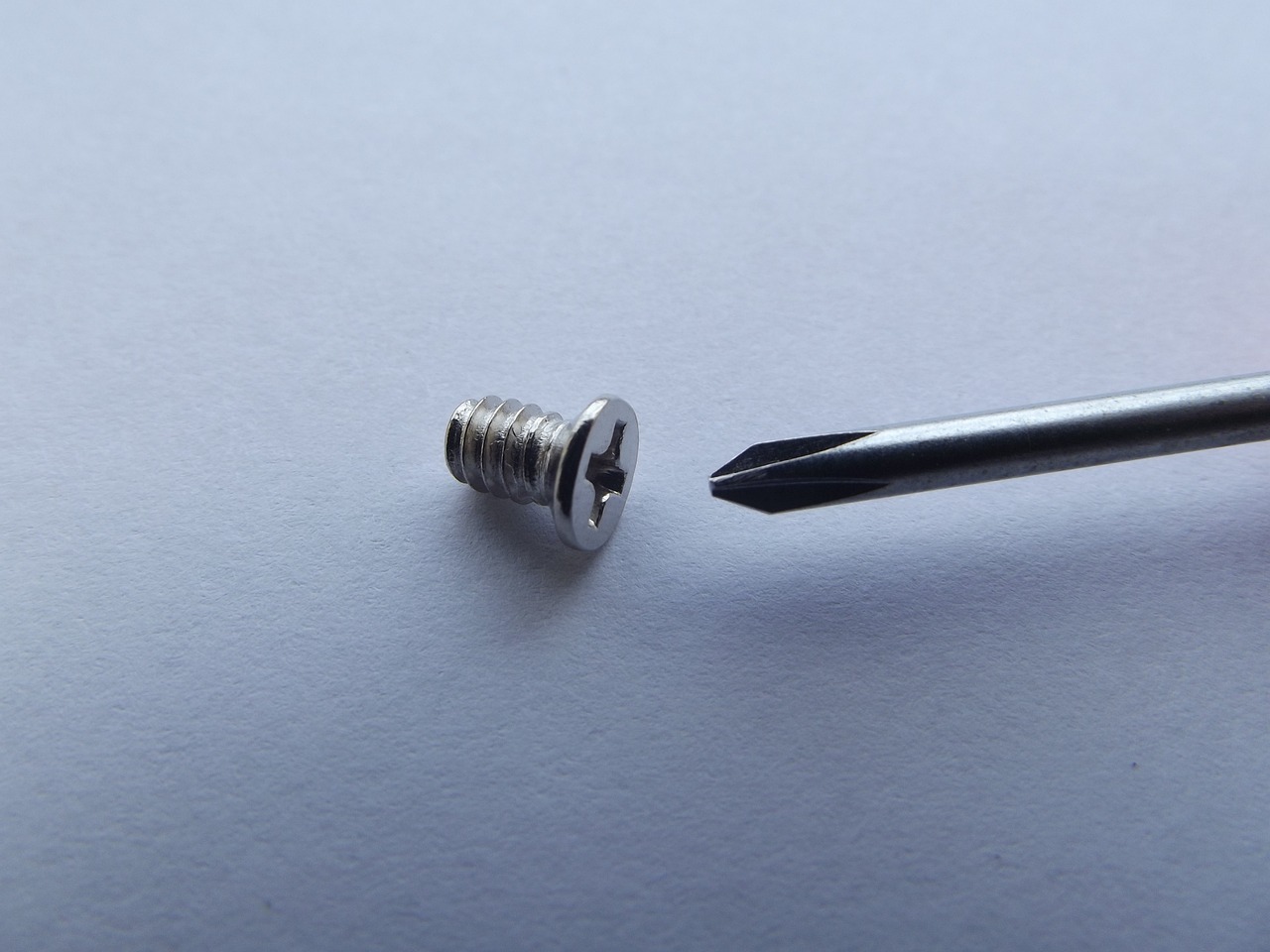
Choosing the Right Grooming Tools
When it comes to grooming your beloved pet, selecting the right tools is absolutely essential. Just like a chef needs the best knives to create a culinary masterpiece, you need the best grooming tools to ensure your furry friend not only looks great but feels comfortable throughout the process. With so many options available, it can be overwhelming to figure out what works best for your pet's unique coat type and grooming needs. But don’t worry! This section will help you navigate the world of grooming tools, ensuring you make informed choices that promote a positive experience.
First and foremost, understanding your pet's coat type is crucial. Different breeds have varying grooming requirements, which means the tools you choose should cater to those specific needs. For instance, long-haired breeds like Persian cats or Golden Retrievers may require different brushes than short-haired breeds such as Beagles or Boxers. A simple rule of thumb is to consider the following:
| Coat Type | Recommended Tools |
|---|---|
| Short Hair | Slicker Brush, Rubber Brush |
| Medium Hair | Pin Brush, Comb |
| Long Hair | Wide-Toothed Comb, Double-Sided Brush |
| Curly Hair | Curved Slicker Brush, Detangling Comb |
Once you have identified the right brush or comb for your pet's coat type, it’s time to think about other grooming tools. Clippers and scissors are also important components of the grooming toolkit. When selecting clippers, ensure they are specifically designed for pets, as human clippers may not be suitable and could lead to discomfort or injury. Look for clippers that are quiet and have adjustable blades, as these features can help minimize anxiety during grooming sessions.
Scissors are essential for trimming delicate areas such as around the eyes, paws, and ears. It's wise to choose rounded-tip scissors to avoid accidental nicks. Remember, the goal is to make grooming a stress-free experience for your pet, so investing in high-quality tools will pay off in the long run.
Moreover, don’t forget about the importance of grooming gloves. These nifty tools not only help remove loose fur but also provide a gentle massaging effect that many pets find soothing. Using gloves can turn grooming into a bonding experience, making your pet feel secure and loved.
In summary, choosing the right grooming tools is about understanding your pet's specific needs and selecting equipment that enhances their comfort. By investing in the right brushes, clippers, and additional tools, you can transform grooming from a dreaded chore into a delightful experience for both you and your furry companion.
- How often should I groom my pet?
It depends on the breed and coat type. Long-haired pets may require grooming several times a week, while short-haired pets might only need grooming once a month. - Can I use human grooming tools on my pet?
It’s not recommended as human tools may not be designed for pet coats and could cause discomfort or injury. - What should I do if my pet resists grooming?
Start slowly and use positive reinforcement. Make the experience enjoyable by offering treats and praise.
Brushes and Combs
When it comes to grooming your furry friend, the right brushes and combs can make all the difference. Just like we have our favorite hair tools, pets need tools suited to their unique coat types. Using the appropriate grooming tools not only makes the process smoother but also helps in keeping your pet comfortable and happy. Imagine trying to brush your hair with a fork—definitely not the best experience, right? The same goes for our pets!
First things first, let’s talk about brushes. There are various types available, each designed to target specific coat types and grooming needs. For instance, if your pet has a long, flowing coat, a slicker brush can be a game-changer. It helps to untangle knots and remove loose hair effectively. On the other hand, for short-haired pets, a bristle brush can do wonders in distributing natural oils, keeping their coat shiny and healthy. Here’s a quick guide to help you choose the right brush:
| Coat Type | Recommended Brush | Purpose |
|---|---|---|
| Long Hair | Slicker Brush | Detangles knots and removes loose hair |
| Short Hair | Bristle Brush | Distributes oils and removes dead hair |
| Curly Hair | Wide-Toothed Comb | Prevents matting and removes tangles |
| Double Coat | Undercoat Rake | Removes loose undercoat and reduces shedding |
Now, let’s not forget about combs. Combs are essential for pets with longer or thicker coats. They help in removing tangles and can be particularly useful in sensitive areas like behind the ears or under the legs. A wide-toothed comb is excellent for detangling while a fine-toothed comb can help in checking for pests like fleas. You might think of a comb as a fine-tuner, ensuring your pet's coat is perfectly groomed and free of any hidden surprises!
In addition to choosing the right tools, it’s crucial to understand how to use them correctly. Always start with gentle strokes, especially in areas where your pet might be sensitive. If your furry buddy seems to squirm or show signs of discomfort, take a break and give them a little love. Remember, grooming should be a bonding experience rather than a chore. By using the right brushes and combs, you’re not just grooming your pet; you’re also building trust and making them feel cherished.
So, the next time you prepare for a grooming session, think of it as an opportunity to pamper your pet. With the right tools in hand, you can turn a potentially stressful experience into a delightful one. After all, a happy pet means a happy owner!
- What type of brush is best for my dog? It depends on your dog's coat type. Long-haired dogs benefit from slicker brushes, while short-haired dogs do well with bristle brushes.
- How often should I groom my pet? It varies by breed. Long-haired pets may need grooming several times a week, while short-haired pets might only need it once a week.
- Can grooming help with shedding? Yes! Regular grooming helps remove loose fur and reduces shedding around your home.
- Is it necessary to use special grooming tools? Yes, using the right tools tailored to your pet's coat type can enhance the grooming experience and keep them comfortable.
Clippers and Scissors
When it comes to grooming your pet, having the right clippers and scissors can make all the difference between a stressful experience and a pleasant one. Choosing the appropriate tools not only ensures the safety of your furry friend but also contributes to a more enjoyable grooming session. First and foremost, it’s essential to understand the different types of clippers and scissors available, as well as their specific uses for various coat types.
For instance, if your pet has a thick or double coat, a powerful clipper with a high blade speed is crucial. These clippers can efficiently cut through dense fur without pulling or tugging, which can be uncomfortable for your pet. On the other hand, if your pet has a fine or short coat, a quieter clipper may be more suitable, as it will minimize noise and help reduce anxiety during the grooming process.
When selecting scissors, it’s important to consider the size and shape of the scissors as well. Straight scissors are ideal for general trimming, while curved scissors are perfect for shaping around the face and paws. Additionally, thinning shears can help blend and reduce bulk in thicker coats, creating a more polished look. Here’s a quick overview of the different types of grooming scissors:
| Type of Scissors | Use |
|---|---|
| Straight Scissors | General trimming and shaping |
| Curved Scissors | Shaping around the face and paws |
| Thinning Shears | Reducing bulk and blending |
Using these tools effectively requires a bit of practice. Start by introducing your pet to the clippers and scissors gradually. Allow them to sniff and explore the tools before you begin grooming. This not only helps them get used to the equipment but also builds trust between you and your pet. When you do start using the clippers, begin with small sections of fur and always keep the blade parallel to the skin to avoid any accidental nicks.
Furthermore, always remember to check the condition of your tools. Dull blades can pull on the hair and cause discomfort, so keeping your clippers and scissors sharp is essential. Regular maintenance, such as cleaning and oiling your clippers, will not only prolong their lifespan but also ensure a smooth grooming experience for your pet.
In conclusion, investing in the right clippers and scissors is a vital step in creating a stress-free grooming environment for your pet. By understanding the types of tools available and how to use them properly, you can make grooming a more positive experience, leading to a happier and healthier pet.
- How often should I groom my pet? The frequency of grooming depends on your pet's breed and coat type. Long-haired breeds may need grooming several times a week, while short-haired breeds might only need it once a month.
- What should I do if my pet is afraid of clippers? Gradually introduce your pet to the clippers, allowing them to get used to the sound and feel. Use treats and positive reinforcement to create a positive association.
- Can I use human grooming tools on my pet? It's best to use tools specifically designed for pets, as human tools may not be safe or effective for animal grooming.
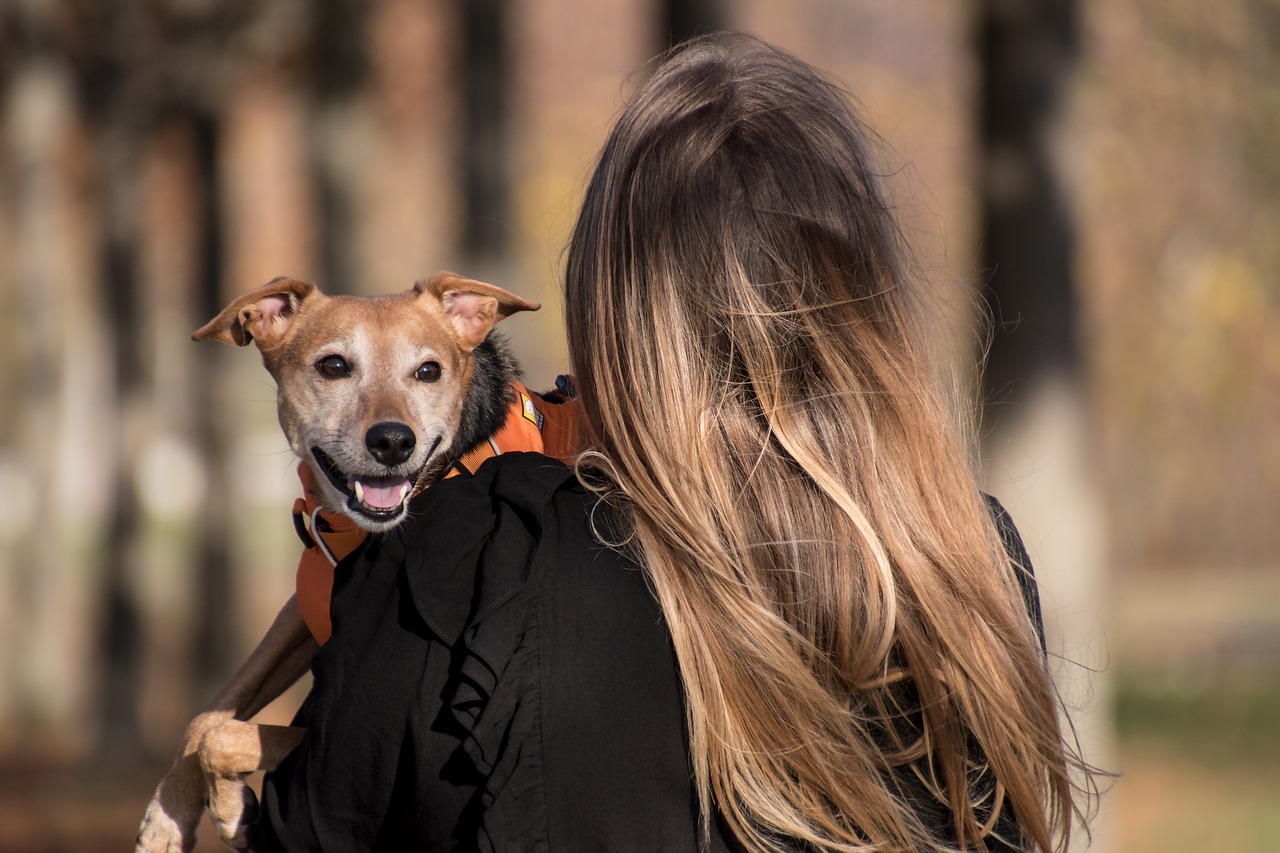
Establishing a Grooming Routine
Creating a consistent grooming routine is like setting the stage for a great performance; it helps your pet know what to expect and can significantly reduce their anxiety. Just like humans thrive on routine, our furry friends do too! When you establish a grooming schedule, your pet begins to associate grooming with regularity and comfort, making the entire process smoother for both of you.
Start by determining how often your pet needs grooming based on their breed, coat type, and activity level. For instance, long-haired breeds may require more frequent grooming than short-haired ones. Here’s a quick guide to help you:
| Coat Type | Recommended Grooming Frequency |
|---|---|
| Long-haired | Every 2-4 weeks |
| Short-haired | Every 4-6 weeks |
| Curly-haired | Every 6-8 weeks |
Once you have a frequency in mind, consider the duration of each grooming session. It’s essential to keep sessions manageable. Start with shorter sessions of about 10-15 minutes, especially if your pet is new to grooming or shows signs of anxiety. Gradually increase the duration as your pet becomes more comfortable. This approach is akin to easing into a cold pool; the slow introduction helps your pet adjust without feeling overwhelmed.
Another vital aspect of establishing a grooming routine is incorporating positive reinforcement techniques. This means rewarding your pet with treats, praise, or playtime during and after grooming sessions. Doing so helps create a positive association with grooming. For example, you might say, “Good boy!” while brushing your dog and then offer a treat afterward. This simple act can transform their perception of grooming from a chore into a delightful experience!
Additionally, consider the time of day that works best for your pet. Some pets are more relaxed in the morning, while others may prefer the evening. Pay attention to your pet's behavior and choose a time that aligns with their natural energy levels. This attention to detail can significantly enhance their grooming experience.
Finally, consistency is key. Try to stick to the same day and time each week or month for grooming. This regularity not only helps you remember but also allows your pet to anticipate grooming sessions. Over time, your pet will likely come to view grooming as a normal part of their routine, much like their daily walks or mealtimes.
- How often should I groom my pet?
It depends on the breed and coat type. Long-haired pets may need grooming every 2-4 weeks, while short-haired ones can go 4-6 weeks. - What if my pet doesn't like grooming?
Start slowly, use positive reinforcement, and ensure the grooming environment is calm and familiar. - Can I groom my pet myself?
Yes! With the right tools and techniques, you can groom your pet at home. Just be sure to research the best practices for your pet's specific needs. - When should I consider a professional groomer?
If your pet has special grooming needs or if you're unsure how to handle their grooming, a professional groomer can help.
Frequency and Duration
When it comes to grooming your pet, finding the right frequency and duration is key to ensuring they remain comfortable and happy throughout the process. Just like humans, pets have their own unique needs, and these can vary significantly based on their breed, age, and coat type. So, how do you determine what’s best for your furry friend? Well, let’s break it down!
First off, consider the type of coat your pet has. For instance, long-haired breeds such as Golden Retrievers or Persian cats typically require more frequent grooming sessions—at least once a week—to prevent mats and tangles. On the other hand, short-haired breeds like Beagles or Boxers might only need a good brush every couple of weeks. This variation can be likened to how some people need to visit the salon more often than others based on their hair type.
Next, let’s talk about duration. A grooming session doesn’t have to last for hours on end, and in fact, shorter, more frequent sessions can often be less stressful for your pet. Aim for grooming sessions that last anywhere from 15 to 30 minutes. This allows you to cover the essentials without overwhelming your pet. You might be surprised how a little bit of regular maintenance can save you from marathon grooming sessions later!
Additionally, pay attention to your pet’s behavior during grooming. If they seem restless or anxious, it may be a sign that you need to shorten the duration of your sessions. Just like humans, pets can have their off days, and it’s important to respect their comfort levels. You can gradually increase the time as they become more accustomed to the routine.
To help you visualize this better, here’s a simple table that outlines grooming frequency based on coat types:
| Coat Type | Recommended Frequency | Session Duration |
|---|---|---|
| Long-haired | Once a week | 30-45 minutes |
| Medium-haired | Every 2 weeks | 20-30 minutes |
| Short-haired | Every 3-4 weeks | 15-20 minutes |
Remember, the goal is to create a positive grooming experience that builds trust between you and your pet. Consistency is crucial, so try to establish a routine that works for both of you. In time, your pet will begin to look forward to these sessions, seeing them as a bonding time rather than a chore. So, keep it light, fun, and engaging, and watch your furry friend thrive!
- How often should I groom my pet? - It varies by breed and coat type. Long-haired pets need more frequent grooming compared to short-haired ones.
- What should I do if my pet hates grooming? - Start with shorter sessions and use positive reinforcement to help them associate grooming with good experiences.
- Can I groom my pet at home? - Absolutely! Just ensure you have the right tools and take your time to make it enjoyable for your pet.
Positive Reinforcement Techniques
When it comes to grooming, your pet's comfort is paramount, and one of the most effective ways to enhance their experience is through . Think of it as a way to turn grooming from a dreaded chore into a fun bonding experience! Just like how a child is more likely to enjoy doing homework if they know there's a reward at the end, your furry friend will feel more at ease knowing that good behavior during grooming leads to tasty treats or extra cuddles.
First and foremost, it’s essential to create a calm environment during grooming sessions. Start by introducing your pet to the grooming tools before you even begin. Allow them to sniff and explore the brushes, clippers, and scissors. This familiarity can greatly reduce anxiety. Once they seem comfortable, you can begin the grooming process. As you work through their fur, incorporate positive reinforcement by offering verbal praise and treats at various intervals. For instance, after brushing a section of their coat, reward them with a small treat and a gentle “good job!”
Another effective technique is to use clicker training. This method involves using a clicker to mark the exact moment your pet exhibits calm behavior during grooming. For example, if they sit still while you brush their tail, click the clicker and immediately give them a treat. This creates a clear association between good behavior and rewards, making your pet more likely to repeat that behavior in the future.
Consistency is key. Establish a routine where grooming becomes a regular part of your pet's life. Over time, they will begin to associate grooming with positive experiences. You might even consider scheduling short, frequent grooming sessions instead of long, daunting ones. This way, your pet won’t feel overwhelmed, and you can shower them with praise and rewards more often. Just remember, patience is a virtue! If your pet shows signs of anxiety, take a step back, and try again later. It’s all about building trust.
Incorporating distractions can also be beneficial. Some pets may respond well to having their favorite toy nearby or even playing soft music in the background. The goal is to create an environment that feels safe and enjoyable. Additionally, you can use treat-dispensing toys to keep them occupied while you groom them. This not only distracts them but also reinforces the idea that grooming is a fun activity.
Lastly, always end grooming sessions on a positive note. If your pet has been cooperative, make sure to reward them with a special treat or extra playtime. This reinforces their good behavior and helps them look forward to future grooming sessions. Remember, the goal is to create a positive association with grooming, so every little bit of encouragement counts!
- How often should I groom my pet? The frequency of grooming depends on your pet's breed and coat type. Long-haired breeds may need grooming several times a week, while short-haired breeds may only require grooming once a month.
- What if my pet is still anxious after trying positive reinforcement? If your pet continues to show signs of anxiety, consider consulting a professional groomer or a veterinarian for additional strategies tailored to your pet's specific needs.
- Can I use treats during grooming? Yes! Using treats is a great way to reward your pet and encourage calm behavior during grooming sessions.
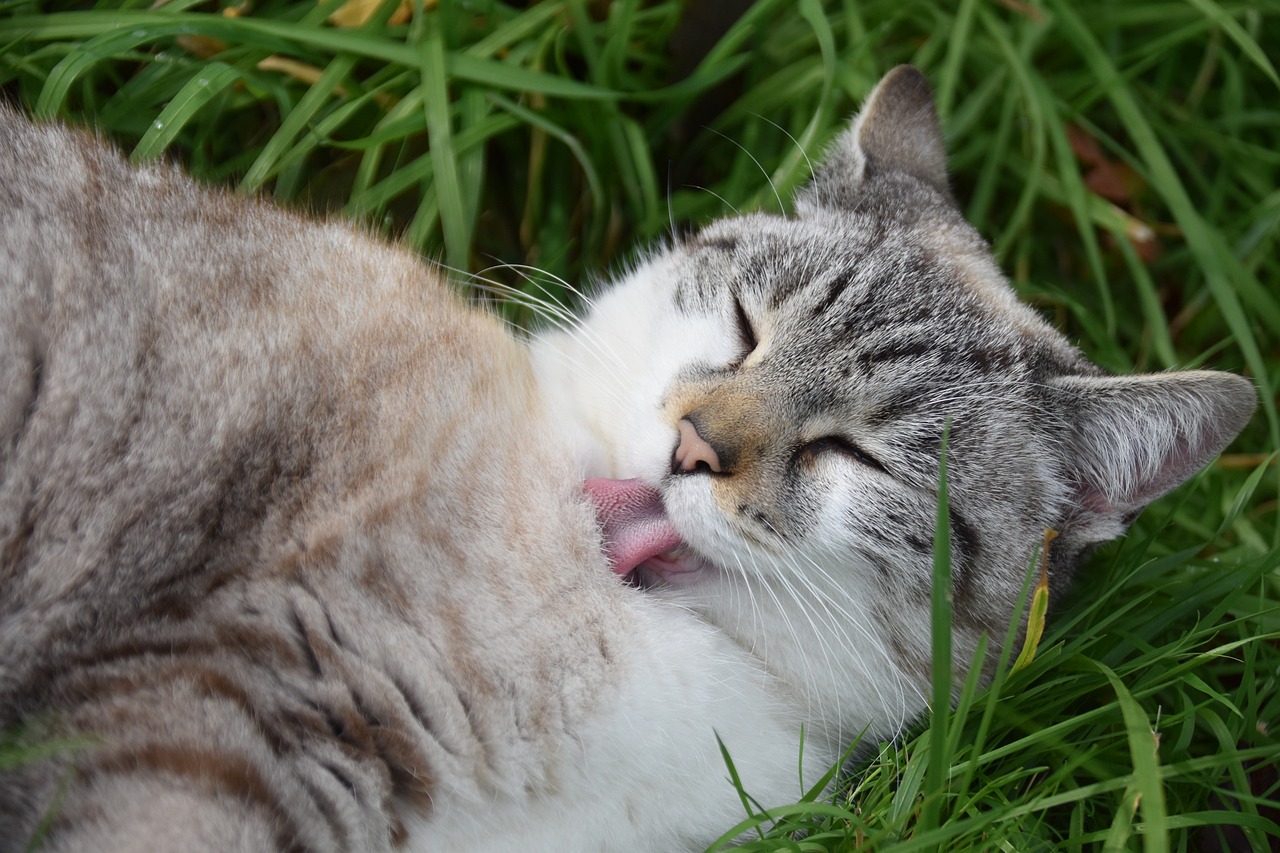
Finding Professional Help
Sometimes, despite our best efforts, our furry friends may need a little extra support when it comes to grooming. Professional groomers can be a game-changer, especially for pets that are particularly anxious or have specific grooming needs. But how do you know when it's time to seek professional help? And once you've made that decision, how do you choose the right groomer? These are essential questions that every pet owner should consider.
First off, it's important to recognize the signs that your pet might benefit from a professional groomer. If your pet consistently shows signs of extreme anxiety during grooming sessions at home, such as excessive vocalization, trembling, or even aggression, it may be time to call in the experts. Professional groomers are trained to handle these situations with care and expertise, providing a calmer environment that can help ease your pet’s fears.
When searching for a qualified groomer, look for someone who not only has experience but also a genuine love for animals. Here are a few tips to help you find the right fit:
- Ask for Recommendations: Talk to fellow pet owners, your veterinarian, or local pet shops for recommendations.
- Check Reviews: Online reviews can provide insights into the experiences of other pet owners.
- Visit the Facility: A quick visit can help you gauge the cleanliness and atmosphere of the grooming salon.
Once you've narrowed down your options, don’t hesitate to ask questions. Inquire about the groomer's approach to handling anxious pets and what techniques they use to create a stress-free environment. It's essential to feel comfortable with the groomer, as this will translate to a better experience for your pet.
Preparation is also key when it comes to grooming appointments. Before the big day, take some time to get your pet used to the idea of being groomed by practicing at home. Brush their fur, trim their nails, and get them accustomed to being handled. This can help reduce anxiety and make the transition to a professional groomer smoother.
In summary, finding the right professional help can significantly ease your pet's grooming anxiety. By recognizing when your pet needs assistance, choosing a qualified groomer, and preparing adequately for the appointment, you can ensure a positive grooming experience that benefits both you and your furry friend.
- How do I know if my pet needs professional grooming? If your pet shows signs of anxiety during grooming at home, or if they have specific grooming needs that you are unable to meet, it may be time to seek professional help.
- What should I look for in a groomer? Look for recommendations, check reviews, visit the facility, and ask about their experience with anxious pets.
- How can I prepare my pet for a grooming appointment? Practice grooming at home to familiarize your pet with the process and reduce anxiety.
Choosing a Qualified Groomer
When it comes to grooming your beloved pet, finding a qualified groomer is crucial for ensuring their comfort and well-being. Just like you wouldn’t trust your hair to anyone, your furry friend deserves a groomer who understands their unique needs. So, how do you find the right one? Here are some key factors to consider:
First, look for groomers who have certifications and experience in handling various breeds. A qualified groomer should have undergone training that covers not just the technical aspects of grooming but also animal behavior. This knowledge is vital; it helps them recognize when a pet is stressed or uncomfortable, allowing them to adjust their approach accordingly.
Next, consider the grooming environment. A good groomer will have a clean, organized, and safe space for your pet. Take a moment to visit the grooming salon before making a decision. Observe how the staff interacts with the pets and check for any signs of stress or anxiety. A calm environment can make all the difference in your pet's grooming experience.
Additionally, don’t hesitate to ask for references or read online reviews. Feedback from other pet owners can provide valuable insights into a groomer's reputation and the quality of their service. Look for comments about how the groomer handled pets, especially those with grooming anxiety.
Another important aspect is the groomer's communication skills. A qualified groomer should be willing to discuss your pet’s grooming needs and any concerns you may have. They should be open to answering your questions and providing recommendations tailored to your pet's specific coat type and temperament.
Lastly, consider scheduling a trial grooming session. This allows you to see how the groomer interacts with your pet and how your furry friend responds to the grooming process. It’s a great way to gauge whether the groomer is a good fit for your pet’s needs.
In summary, choosing a qualified groomer involves careful consideration of their qualifications, environment, communication, and your pet's comfort level. By taking the time to find the right groomer, you can help ensure that your pet enjoys a positive grooming experience.
- How often should I groom my pet? The frequency of grooming depends on your pet's breed and coat type. Long-haired breeds may require grooming every few weeks, while short-haired breeds might only need it once a month.
- What should I do if my pet is anxious during grooming? Gradually acclimate your pet to the grooming process at home and consider using positive reinforcement techniques to create a more positive association with grooming.
- Can I groom my pet at home? Yes, many pet owners groom their pets at home. However, it's important to have the right tools and knowledge to do it safely and effectively.
- When should I seek professional grooming help? If your pet shows signs of extreme anxiety, has a matted coat, or requires specialized grooming that you are not comfortable handling, it's best to consult a professional groomer.
Preparing for the Grooming Appointment
Preparing for a grooming appointment is like getting ready for a big event; it requires planning and a little bit of finesse. Just as you wouldn’t want to walk into an important meeting without a game plan, your pet deserves the same consideration. First and foremost, familiarity is key. Before the appointment, introduce your pet to the grooming tools. Let them sniff and explore the brushes, clippers, and combs. This can help demystify the grooming process and reduce anxiety.
Next, consider the environment. If possible, choose a grooming location that is calm and familiar to your pet. If you're using a professional groomer, visit the facility beforehand. This allows your pet to get a feel for the space and meet the groomer, which can make a world of difference. Think of it as a warm-up before the big game—getting comfortable in the space can ease those jitters.
Another important aspect is to schedule the appointment wisely. Avoid booking during your pet’s usual nap time or when they are typically more active. Instead, choose a time when they are calm and relaxed. This can help ensure they are more receptive during the grooming process. Also, keep in mind the duration of the appointment; a long session may overwhelm your pet, so consider shorter appointments to start with.
Don’t forget about positive reinforcement. Bring along some of your pet’s favorite treats or toys. Rewarding them for good behavior during the grooming process can create a positive association with the experience. Imagine how much easier it is to do something daunting when you know there’s a reward waiting for you at the end!
Finally, ensure you have all necessary documents ready, such as vaccination records, especially if you’re visiting a new groomer. This preparation not only helps the groomer but also sets a professional tone for the appointment. Just as you would prepare documents for an important meeting, having your pet’s information at hand can make the process smoother.
In summary, preparing for your pet’s grooming appointment involves a mix of familiarization, scheduling, and positive reinforcement. By taking these steps, you’ll not only help reduce your pet’s anxiety but also foster a more enjoyable grooming experience for both of you.
- How can I tell if my pet is anxious before grooming? Look for signs such as hiding, trembling, or excessive vocalization. Understanding these signals can help you address their fears effectively.
- What tools should I use for my pet’s specific coat type? The right tools vary by coat type. For example, short-haired pets may need a rubber grooming mitt, while long-haired breeds benefit from slicker brushes.
- How often should I groom my pet? Grooming frequency depends on the breed and coat type. Generally, long-haired pets require more frequent grooming than short-haired ones.
- When should I consider professional grooming services? If your pet displays extreme anxiety or if grooming becomes too challenging, it might be time to seek professional help.
Frequently Asked Questions
- What signs indicate my pet is anxious during grooming?
Pets often show anxiety through various behavioral cues. Look for signs such as excessive barking, growling, or whining. Additionally, physical signs like trembling, hiding, or even trying to escape can indicate discomfort. Understanding these signs helps you address their fears and create a more relaxed grooming environment.
- How can I choose the right grooming tools for my pet?
Selecting the right grooming tools is crucial for your pet's comfort. Consider their coat type—short-haired pets may need different brushes compared to long-haired ones. It's essential to use tools that suit their specific needs, such as slicker brushes for tangles or combs for smoothing. Always ensure the tools are safe and comfortable to use.
- What are some positive reinforcement techniques for grooming?
Positive reinforcement can make grooming a more enjoyable experience for your pet. Use treats, praise, and gentle petting to reward calm behavior during grooming. This helps your pet associate grooming with positive experiences, reducing anxiety over time. Consistency is key, so make sure to reinforce good behavior each time.
- How often should I groom my pet?
The frequency of grooming depends on your pet's breed, coat type, and individual needs. Generally, long-haired pets require more frequent grooming—often several times a week—while short-haired pets may only need grooming once every few weeks. Pay attention to your pet's comfort and adjust the grooming schedule as necessary.
- When should I consider professional grooming services?
If your pet shows extreme anxiety during grooming or if you feel unsure about handling their grooming needs, it might be time to seek professional help. A qualified groomer can provide a calming environment and the expertise needed to handle your pet's specific grooming requirements. Look for groomers with good reviews and experience with your pet's breed.
- How can I prepare my pet for a grooming appointment?
Preparation is crucial for easing your pet's anxiety before a grooming appointment. Start by familiarizing your pet with the grooming tools at home. Practice handling their paws and coat gently, and consider taking them for a short visit to the groomer's location before the appointment. This helps them get used to the environment and reduces stress on the actual day.







